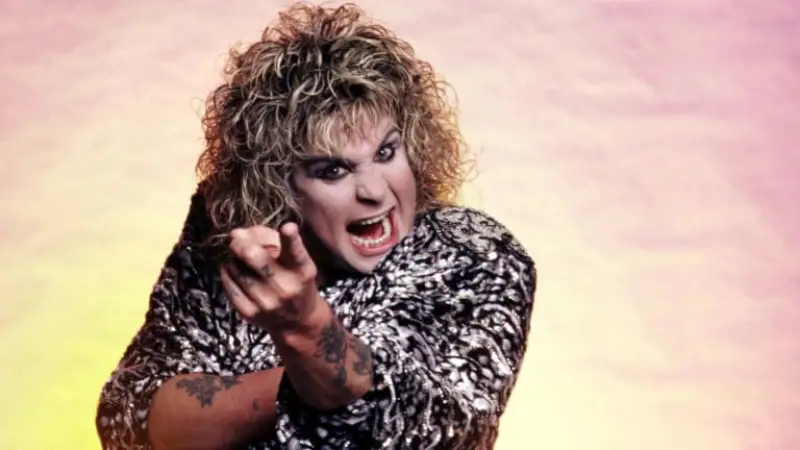Rock and metal music have always been great sources of controversy because of their rebellious nature and Love of pushing limits. Certain characters have surfaced in various genres whose deeds, words, and identities have provoked controversy, resentment, and curiosity. These musicians have made a lasting impression on the music industry with anything from controversial lyrics to outrageous actions, for better or ill. We explore some of the most contentious vocalists in rock and metal history and their lives and legacies.
We look beyond the headlines to discover what motivates these musicians to desire controversy, from the shock tactics of Marilyn Manson to the turbulent career of Axl Rose and from the outrageous antics of GG Allin to the horrible crimes of Ian Watkins and how their actions have shaped the cultural conversation surrounding music. Come along with us as we explore the world of the most controversial characters in rock and Metal, where disagreement frequently sounds like another note in the rebellion’s symphony, and the distinction between art and provocation becomes hazy.
Marilyn Manson:

Marilyn Manson is one of the few musicians who personifies controversy. Manson combined the names of Marilyn Monroe and Charles Manson to become his stage name, which was a bold move in and of itself. He was born Brian Hugh Warner in Canton, Ohio, on January 5, 1969. Manson made it plain early in his career that he was not here to fit in. Manson attracted criticism and censure right once for his androgynous look, dramatic stage presence, and lyrics that addressed themes of violence, sex, and social taboos. Manson’s music, distinguished by its fusion of glam rock, Metal, and industrial elements, frequently acts as a soundtrack for his provocative live performances. His live performances are renowned for pushing boundaries and often include shocking imagery, simulated acts of violence, and elaborate costumes designed to shock and unsettle audiences.
But Manson’s controversy goes beyond what he does on stage. His music and images have been accused of encouraging murder, Satanism, and nihilism; songs like “The Reflecting God” and “Antichrist Superstar” are frequently cited by detractors as proof of his purportedly sinister influence. Manson has experimented with acting in addition to music, showing up in films like “Lost Highway” and “Jawbreaker,” which has further blurred the boundaries between his private and public selves. Manson has faced several issues over his career, such as protests from religious organizations, charges that he was involved in school shootings, and accusations of sexual misconduct. Manson has remained a powerful and significant personality in the music industry, evoking equal parts devotion and disgust despite—or maybe because of—these scandals. Marilyn Manson stands as a testament to the power of art to provoke, challenge, and disturb, a reminder that controversy is often just another name for artistic expression in the world of rock and Metal.
Ozzy Osbourne:

Born John Michael Osbourne on December 3, 1948, in Birmingham, England, Ozzy Osbourne rose to fame as the lead vocalist of the pioneering heavy metal band Black Sabbath. However, his solo career, marked by a tumultuous personal life and a string of controversial incidents, solidified his status as a rock icon. Osbourne’s time with Black Sabbath was defined by musical innovation and personal excess. The band’s dark, heavy sound, characterized by Tony Iommi’s iconic guitar riffs and Osbourne’s haunting vocals, laid the groundwork for the heavy metal genre. However, behind the scenes, Osbourne’s struggles with drug and alcohol addiction were spiraling out of control, leading to his dismissal from the band in 1979. However, Osbourne chose to start a solo career that would propel him to even greater levels of prominence and renown rather than fall into oblivion. 1980 saw the release of “Blizzard of Ozz,” his debut solo album highlighting Osbourne’s unique voice and Love of sad, reflective lyrics. His reputation as rock’s ultimate wild man was confirmed by his spectacular stage antics, of which chewing the head off a live bat at a concert is arguably the most known. Hits like “Crazy Train” and “Mr. Crowley” solidified his prominence as a solo artist.
Osbourne battled his problems on and off stage despite releasing great albums and going on lengthy tours during the 1980s and 1990s. His turbulent relationship with his manager and wife, Sharon Osbourne, and his battles with addiction were well-documented in the media, further adding to his legend as rock’s most notorious hellraiser. Osbourne has been a little more reserved in recent years, partly because of his well-documented health problems, such as Parkinson’s disease. Still, he is regarded as one of the most divisive and adored individuals in music history, and his impact on the rock and metal scene is unabated. Ozzy Osbourne left behind a complicated legacy that is ultimately a story of tragedy, triumph, excess, atonement, and darkness and light. But despite everything, one thing is sure: Ozzy Osbourne will always be regarded as the Prince of Darkness, a genuine rock and roll superstar, whether performing as the frontman for Black Sabbath or on his own.
GG Allin:

Born in Lancaster, New Hampshire, on August 29, 1956, as Jesus Christ Allin, GG Allin was arguably the most radical and contentious person to come out of the punk music movement. By pushing the limits of what was considered appropriate in music and performance art, Allin became a symbol of depravity and rebellion through his wild live performances, nihilistic lyrics, and disturbing behavior. Allin showed signs of rebellion at a young age, running away from home several times and doing violent and destructive actions. Allin started his musical career in the late 1970s with the band The Jabbers, but he didn’t start to get recognition until the 1980s when The Murder Junkies were formed.
Allin’s intense and combative live performances became renowned. He frequently performed self-mutilation, defecation, and even violent assaults on audience members while nude or covered in blood. His songs were similarly thought-provoking, defiantly addressing subjects of drug misuse, violence, and sexual deviance. However, Allin’s controversy extended beyond his theatrical antics. In addition, he was well-known for his behavior off the stage, which included many arrests for offenses including violence and indecent exposure. Allin, who saw himself as a sort of anti-establishment martyr whose only goal was to shock and outrage society, publicly supported anarchy and violence.
Allin’s life was tragically cut short on June 28, 1993, a few days after his last concert, when he overdosed on heroin. GG Allin is still regarded as a cult figure in the punk rock community, admired by some as a misunderstood genius and despised by others as a dangerous madman, despite—or maybe because of—his extreme behaviour and premature death. GG Allin left a lasting impression on the world of music and performance art, whether you love him or not. He pushed the limits of what was considered appropriate in rock and roll with his unwavering dedication to shock and provocation, establishing a legacy that still fascinates and disturbs people today.
Axl Rose:

Axl Rose, whose real name is William Bruce Rose Jr., was born in Lafayette, Indiana, on February 6, 1962. He became well-known as the flamboyant and enigmatic lead vocalist of Guns N’ Roses, one of the most recognizable rock groups of the late 1980s and early 1990s. Rose rose to prominence as a symbol of excess and rebellion in rock & roll due to his strong voice, captivating stage presence, and turbulent personal life. “Appetite for Destruction,” Guns N’ Roses’ debut album, marked their breakthrough in the late 1980s and produced hits like “Welcome to the Jungle” and “Sweet Child of Mine.” Rose emerged as the band’s mysterious leader as they swiftly rose to prominence in the globe thanks to their rough sound and rebellious attitude. However, scandal accompanied success, and Rose’s reputation for erratic behavior quickly eclipsed the band’s musical output. He was well-known for acting erratically both on and off stage, frequently appearing late for performances or getting into heated public arguments with fans, band members, and the media.
One of the most notorious moments in Rose’s career was in 1991 when, after lunging into the crowd to confront a fan who was photographing the event, he started a brawl during a Guns N’ Roses concert in St. Louis. Rose was accused of instigating a riot as a result of the ensuing Mayhem, which resulted in injuries and property damage. However, the accusations were eventually dismissed. Guns N’ Roses endured years of controversy and member changes, but Rose led the group through several iterations and albums like “Use Your Illusion I and II” and “Chinese Democracy.” Even though these albums were met with mixed reviews, Rose’s status as one of rock’s most mysterious and controversial people was solidified.
To the joy of fans worldwide, Guns N’ Roses have successfully organized reunion concerts in recent years, reuniting Rose with old bandmates Slash and Duff McKagan. Rose may never wholly shed his turbulent reputation, but there’s no doubting the influence he and Guns N’ Roses have had on the rock music industry. They carry on with their anthems and extravagant demeanor, and they continue to inspire and entertain audiences worldwide, reminding us that in rock and roll, controversy often goes hand in hand with greatness.
Courtney Love:

Courtney Love, an actress, musician, and artist, was born Courtney Michelle Harrison on July 9, 1964. She gained notoriety as the lead singer of the alternative rock group Hole. Love has become one of the most divisive personalities in the music business due to her raw talent, fiery stage presence, and chaotic personal life. Love’s career started in the late 1980s and early 1990s underground rock scene, where she founded Hole and became well-known for her strong voice and thought-provoking lyrics. Their second album, “Live Through This,” released in 1994 to critical acclaim and made Love a formidable force in the alternative rock scene, was the band’s breakthrough record. Love was talented, but she also had a taste for drama. Her complex relationship with her late husband, singer of Nirvana Kurt Cobain, was closely followed by the media, as was her struggle with drug addiction and her candid opinions on feminism and the music business. Love’s combative demeanor, both on and off stage, cemented her status as a controversial personality. She was well-known for her quick wit, flaming temper, and no-holds-barred style, sometimes resulting in public arguments with journalists, other musicians, and even her admirers.
One cannot overestimate Love’s impact on the rock music industry, despite or perhaps because of her controversies. Her unwavering acceptance of her imperfections and vulnerabilities, along with her bold approach to songwriting, helped redefine the position of women in rock and roll and opened the door for a new wave of female musicians to follow in her footsteps. Love has been pursuing her creative and musical ambitions in recent years, putting out solo albums and making appearances in TV series and films. Despite the ups and downs in her career, one thing is sure: Courtney Love will always be regarded as a genuine iconoclast whose unwavering attitude and unbridled skill helped to mould the alternative music scene for years to come.
Varg Vikernes:

Varg Vikernes, born Kristian Vikernes on February 11, 1973, in Bergen, Norway, is most renowned for creating the one-person black metal band Burzum. But Vikernes’s musical career is only one facet of his contentious and frequently unsettling legacy. When the Norwegian black metal genre first came to prominence in the early 1990s, it was known for its violent deeds, harsh music, and anti-Christian attitude. Vikernes was also involved in church burnings and other violent incidents. Early Burzum albums, distinguished by their raw sound, atmospheric compositions, and low-fidelity production, contributed to the genre’s definition and cemented Vikernes’ standing as a black metal pioneer. However, Vikernes’s role in the murder of Øystein Aarseth (Euronymous), the guitarist of the black metal band Mayhem, and his involvement in a string of church burnings in Norway put him in the public eye. It made him one of the most controversial figures in music history. Vikernes received the maximum 21-year jail sentence permitted by Norwegian law in 1994 after being found guilty of murder and arson.
Vikernes continued to compose music while he was incarcerated, putting out many albums under the Burzum moniker that solidified his reputation as a revered figure in the underground black metal scene. However, as Vikernes promoted racist, anti-Semitic, and other extreme ideologies, his music and opinions grew more and more entwined with far-right philosophy and neo-pagan beliefs that alienated many of his former fans. Following his 2009 release from jail, Vikernes withdrew from public life to concentrate on his family and his divisive writings, which he posts on his website and other social media sites. Varg Vikernes continues to be a divisive figure, vilified by some for his extreme beliefs and praised by others for his musical contributions. Still, there’s no disputing his enduring influence on the black metal scene and the more extensive cultural dialogue about extremism and hate speech.
Gene Simmons:

Gene Simmons, born Chaim Witz in Haifa, Israel, on August 25, 1949, is most renowned for being a founding member, bassist, and co-lead vocalist of the legendary rock group Kiss. Simmons solidified his reputation as one of music’s most colorful personalities by defining the glam rock period of the 1970s with his flamboyant stage demeanor, striking makeup, and larger-than-life attitude. After founding in 1973, Kiss gained rapid notoriety for their extravagant live performances that included pyrotechnics, tongue-wagging antics, and lavish costumes. Popular songs such as “Detroit Rock City” and “Rock and Roll All Nite” established the band as a mainstay of classic rock radio and won them hordes of loyal followers worldwide. Although Kiss was renowned for their dazzling music and extravagant live performances, Simmons was no stranger to controversy. Because of his unreserved acceptance of luxury and extravagance, as well as his occasionally contentious comments on everything from politics to religion, Simmons was frequently the subject of public discussion and media attention.
Simmons’ trademark registration for the “devil horns” hand signal, which he claimed to have devised, is one of the most persistent controversies surrounding him. Many have criticized Simmons for trying to patent a gesture that has been a part of rock and metal culture for decades—raising the index and pinky fingers while tucking the middle and ring fingers into the palm use for much longer than he claims. Despite his troubles, or maybe because of them, Simmons is still a well-liked character in the rock music industry, respected for his financial sense, charitable endeavors, and commitment to his followers. While his extravagant lifestyle may occasionally obscure his musical accomplishments, there’s no doubt that Gene Simmons and Kiss have had a lasting impression on the rock and roll industry, encouraging many fans and musicians to embrace their inner rock stars.
Ian Watkins:

Ian Watkins was the former lead vocalist of the Welsh rock group Lostprophets. Regretfully, his name is now linked to one of the most startling and unsettling incidents of criminal activity involving a singer. After entering a guilty plea to 13 crimes in 2013, which included attempted child rape and sexual assault as well as the possession and dissemination of pornographic photographs of children, Watkins was given a 29-year jail term. His atrocious and extremely unsettling crimes shocked the music business as well as the general population. Not only did the disclosures of Watkins’s misdeeds damage the standing of Lostprophets, but they also created a cloud over the whole rock music industry. The unsettling truth that someone they previously looked up to and revered might be capable of such horrible deeds left them reeling.
Following Watkins’s apprehension and conviction, Lostprophets called it quits, and the other band members distanced themselves from him, voicing astonishment and dismay at his behaviour. Ian Watkins’s story is a sad reminder of the shadowy side that often exists beneath achievement and notoriety. It also emphasizes how crucial it is to hold people responsible for their deeds, regardless of their standing in society or level of popularity. Watkins’s crimes have permanently damaged his reputation and serve as a sharp reminder about the risks of idolizing prominent personalities without correctly understanding them, even though his songs may have previously struck a chord with admirers.
Conclusion
To sum up, the realm of rock and Metal has given rise to a wide range of contentious personalities, each of whom has left a lasting impression on the music business and popular culture at large. From the crazy antics of GG Allin to the terrible collapse of Ian Watkins, and from Marilyn Manson’s provocative theatrics to Ozzy Osbourne’s famous adventures, these artists have pushed the frontiers of artistic expression, questioned society standards, and frequently courted controversy in the process. These characters represent excess, immorality, and even danger, yet some may regard them as symbols of resistance and insurrection. But regardless of one’s viewpoint, these musicians have had a lasting influence on the music industry and the broader cultural landscape. Ultimately, the tales of these contentious vocalists serve as a reminder of the nuanced interactions between morality, fame, and the arts, as well as the ability of music to bring people together and drive them apart. Whether loved or hated, these characters will always be remembered in the annals of rock and metal history for forcing us to face complex realities and consider the complexity of the human condition.








